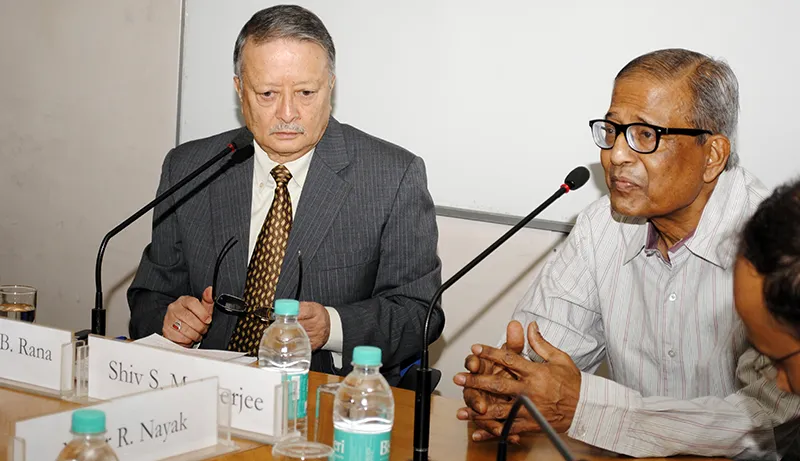The revival of South Western Silk Road would promote connectivity as well as enhance economic ties between India, Nepal and China, according to experts who participated in a discussion at ORF.

The revival of South Western Silk Road would promote connectivity as well as enhance economic ties between India, Nepal and China, said Dr Pradumna Rana, Associate Professor, S. Rajaratnam School of International Studies, Nanyang Technological University, during a discussion at Observer Researcher Foundation on June 23, 2014. The discussion was chaired by Mr. Shiv Mukherjee, former Indian Ambassador to Nepal, who set the tone of the discussion by arguing that Silk Road was the first attempt at globalisation.
Dr Rana, in his presentation, pointed out that there were two Silk Roads in Asia - the Northern and the less well-known South-western Silk Road (SSR). The southwestern Silk Road that began from Yunnan, passed through Myanmar, India, Nepal, and Tibet and looped back to Yunnan. It was a circular corridor. After enjoying a rich history of around 1600 years, the Silk Roads went into disrepair. Now, for various economic, security, and political reasons, land connectivity is once again making a comeback in Asia. He said while the focus has been mainly on reviving the Northern Silk Road, less attention has been paid to revive SSR.
Citing his case for a seamless pan-Asian connectivity, Dr Rana said that Silk Road was at its highest peak during the Mongol Empire (13th century) but declined subsequently due to the isolationist policies adopted by various dynasties. The industrial revolution spelled further doom with steam-engined ships connecting the world through maritime trade routes.
He argued that sea connectivity will continue to play a dominant role in trade but land connectivity has regained primacy as seen in China’s "New Silk Roads" policies which seek to enhance connectivity between neighboring countries. Similarly the "New Silk Road" Economic Belt policy announced by Chinese President Xi Jinping in Central Asia in 2013 was aimed at jointly developing infrastructure in Asia and beyond, even Africa. Big corporate house are moving into the country’s interior with the aim to move their products by road instead of coastal shipping, Dr Rana pointed out.
China’s success in infrastructure development is well known. Lhasa has emerged as major transportation hub in western China-- five major Chinese highways converge there. The Beijing-Tibet railway has reached Shigaste and will reach Nepal’s borders in the future. Likewise, the Beijing-Lhasa expressway has been completed. These economic corridors would further lead to better road connectivity between ASEAN-India through Mekong-India Economic corridor and the Trilateral Highway Bangladesh-China-India-Myanmar Economic Cooperation (BCIM) Economic Corridor. It would also increase the volume of trade across borders. Finally, the potential for parts and components or supply-chain trade between South Asia and East Asia has enhanced the case for improved multimodal connectivity between south Asia and east Asia. "Our proposal is not to simply establish "transport" corridors but "economic" corridors which are broader and include physical planning of the corridor and surrounding areas to attract businesses, special economic and industrial zones, and dry ports, "he said.
Dr Rana believed that strengthening economic linkages between South Asia and East Asia would result in faster and more resilient growth as well as win-win position for both the regions. This would reduce poverty and improve the social indicators of both the ends, he concluded.
Dr Ram Upendra Das, Professor, Research and Information System for Developing Countries, commenting on the presentation added that in the trilateral cooperation Nepal was a key player in the Silk Road. He was of the opinion that the trilateral agreement would be determined by the bilateral agreement between India and Nepal.Dr Jayshree Sengupta, Senior Fellow, gave an overview of the business environment in the region and argued that China stood to benefit more from the proposed economic corridors. But, she pointed out that both Nepal and India could also leverage China’s economic compulsions to their advantage. Mr Nihar Nayak of Institute of Defence Studies and Analyses, in his remarks, cautioned about the security concerns which India and China might have regarding the proposed economic corridors.
(This report is prepared by Bhavya Pandey, Research Intern, Observer Research Foundation, Delhi)
The views expressed above belong to the author(s). ORF research and analyses now available on Telegram! Click here to access our curated content — blogs, longforms and interviews.




 PREV
PREV

